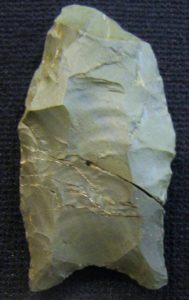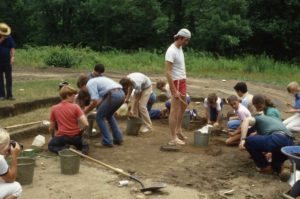Templeton Site

The Templeton Site is a 11,190-year-old Paleo-Indian site located on a terrace of the Shepaug River in Washington, Connecticut. Archaeological data recovered from the Templeton site suggests that groups of this time period used it as a tool-making camp which is representative of typical Paleo-Indian settlement patterns in New England. Rather than occupying one camp year round, groups would move across the land and stay at camps designed for short term occupation and specialized subsistence activities.
One of the most prominent discoveries from the Templeton site came in the form of charred red oak and juniper/white cedar remains which challenged archaeologists’ understanding of Paleo-Indians as well as the Paleo environment. Prior to this discovery, groups inhabiting the Northeast during this time period were thought of as “big game hunters” that survived on mastodon meat as they wandered through the barren tundra environment. The presence of these charred botanical remains points to a much more diverse landscape with denser forests and a variety of micro-environments. Additionally, this is suggestive of a vastly different faunal composition than previously thought. Rather than cold climate dwellers like mastodon, animals such as white-tailed deer, which browse on oak leaves and acorns, were the likely inhabitants of this biome. In fact, new research suggests that Paleo-Indians in New England relied heavily on the migration of caribou for food. As groups followed caribou herds across the landscape, they inhabited small, short-term camps along the way. These temporary camps were vital for making tools on the move; Templeton is likely a reflection of this. Year after year, Paleo-Indian groups would utilize these camps and store caches of their tools so that they could return the following year. Some other tools that were used are fluted point production, which can be seen from the multitude of fluted preform fragments and channel flakes found. These lithics were used for numerous tasks such as woodworking as seen in the microwear analysis of some of these artifacts.
Another misconception that was debunked by the Templeton site was that Paleo-Indian groups traveled nomadically. While it is true that people were highly mobile, they were not nearly as nomadic as previously believed because the environment would have offered more resources than assumed in the “big game hunters” subsistence model. Radiocarbon dates from the Templeton site indicate that it was occupied again during the Early and Late Archaic periods. Clearly, Templeton was highly significant to the people in this area since they returned to the site again thousands of years later for further exploitation of the local natural resources.
Citations
Roger W. Moeller
1984 Paleo-Indian and Early Archaic Occupations in Connecticut. Bulletin of the Archaeological Society of Connecticut, Volume 47: 41-47. Edited by Renee Kra.
1980.6LF21 A Paleo-Indian Site in Western Connecticut. Published by the American Indian Archaeological Institute, Occasional paper number 2
Zachary Singer, Peter Leach, Heather Rockwell, Tiziana Matarazzo, Krista Dotzel, Roger Moeller
ND Intra-Site Spatial Patterning of the Templeton Paleoindian Site in Western Connecticut. www.wcsu.edu/socialsci/wp-content/uploads/sites/108/2018/07/Intra-Site-Spatial-Patterning-Templeton-Paleoindian-Site-Western-Connecticut.pdf




